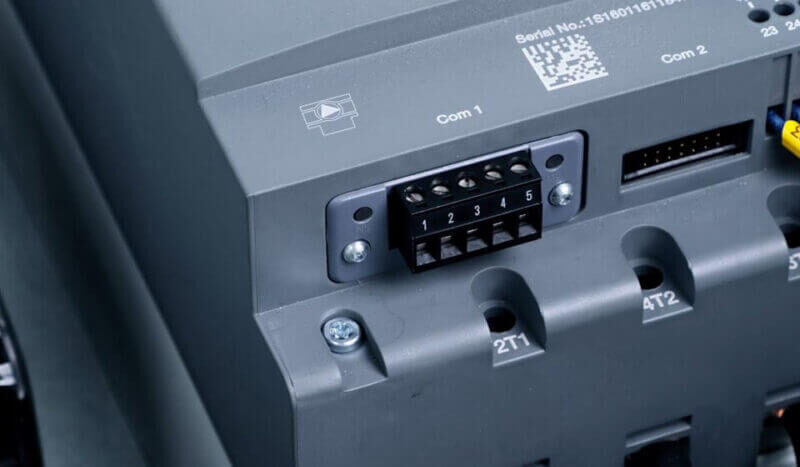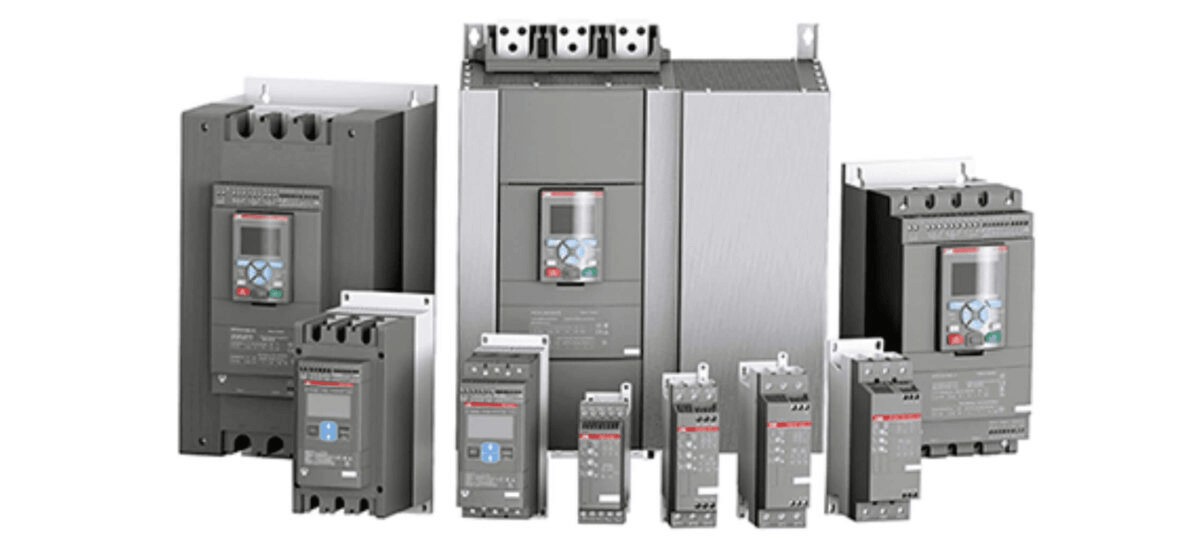
Soft Starter: An Essential Motor Control Solution
A soft starter is an electrical control device designed to enable smooth and controlled starting and stopping of electric motors. By gradually increasing the voltage supplied to the motor, it reduces electrical and mechanical stress, optimizes operational efficiency, and extends equipment life. This controlled start-up limits inrush current and torque, protecting both the motor and connected mechanical systems.
1. What Is a Soft Starter?
A soft starter is an add-on device used with AC motors to reduce electrical stress during startup. Instead of supplying full voltage immediately, it ramps up the power smoothly, reducing wear and mechanical strain.
Many soft starters use solid-state components, such as thyristors (SCRs), to regulate the voltage in three stages. These semiconductors switch between on/off states to control current flow and gradually increase voltage until full power is reached.
Mechanical soft starters are also available, using components like fluid couplings or magnetic couplings to achieve a similar effect through mechanical means.
2. Soft Starter Schematic Diagram
A typical soft starter for a three-phase induction motor consists of:
- Six SCRs (two per phase, in anti-parallel configuration)
- Control circuitry, such as a PID controller or microcontroller
- Power supply with rectifier
- Protection components: circuit breakers, overload relays (OLR), magnetic contactors
- Bypass contactor: switches full voltage to the motor once it reaches full speed

3. Working Principle
Soft starters work by adjusting the firing angle of SCRs. When a trigger pulse is applied at a specific angle, the thyristor begins to conduct current, allowing partial voltage through. As the motor starts, the firing angle gradually decreases, increasing the conduction period and voltage.
- Zero-crossing detection is used to synchronize firing pulses.
- Initially, pulses begin near 180°, limiting voltage.
- Gradually, the angle reduces to 0°, allowing full voltage.
- Once full speed is achieved, bypass contactors engage, and SCRs stop firing.
Bypass contactors can be internal (space-saving) or external (for higher-capacity systems).
4. Advantages of Soft Starters
- Smooth Start-up: Reduces mechanical shock and electrical stress
- Adjustable Acceleration/Deceleration: Fine-tune motor behavior
- No Inrush Current: Prevents electrical surges
- Frequent Start/Stops: Suitable for applications requiring multiple starts per hour
- Reduced Overheating: Prevents high winding current during startup
- Extended Motor Life: Minimizes wear and mechanical failure
- Lower Maintenance: Less stress = fewer failures
- Energy Efficient: Low energy usage during startup
- Compact Design: Smaller footprint than other control systems
- Cost-Effective: More affordable than VFDs for basic motor control
5. Disadvantages of Soft Starters
- No Speed Control: Frequency remains constant; speed depends on load
- Heat Generation: SCRs dissipate heat, requiring heatsinks
- Reduced Starting Torque: Not suitable for high-torque startup applications
6. Common Applications
Soft starters are ideal for constant-speed motor applications where smooth startup is crucial:
- Industrial Fans: Provide controlled acceleration
- Conveyor Belts: Prevent load displacement or belt damage
- Pumps: Avoid water hammer or pipe pressure surges
- Belt-Driven Motors: Reduce shock loads in pulley systems
- HVAC Compressors: Especially for single-phase systems

7. Soft Starter vs. VFD
| Feature | Soft Starter | VFD (Variable Frequency Drive) |
|---|---|---|
| Start/Stop Control | ✔️ | ✔️ |
| Speed Regulation | ❌ (Fixed Frequency) | ✔️ (Adjustable Frequency) |
| Energy Savings | ⚠️ Limited to start-up phase | ✔️ Continuous energy optimization |
| Application | Simple, cost-sensitive applications | Complex or dynamic speed control needs |
8. When to Choose a Soft Starter vs. VFD
- Choose a soft starter when:
- You need smooth motor starts and stops
- The motor runs at constant speed
- Cost and space are key concerns
- Choose a VFD when:
- You require variable speed control
- Precise torque or process control is necessary
- Energy savings during runtime are important
9. Common Soft Starter Failures
Though generally reliable, soft starters can fail due to:
- Overheating: Inadequate cooling or ambient temperature
- Overvoltage or Overcurrent: Can damage SCRs and control circuits
- Component aging: SCRs and control relays degrade over time
Proper design, environment control, and regular maintenance are key to longevity.
10. Choosing the Right Soft Starter for Your Facility
To select the right soft starter, evaluate:
- Motor specifications (current, voltage, torque)
- Start/stop frequency
- Load type and torque demand
- Control enclosure requirements
- Protection features (overload, fault diagnostics)
- Space and budget limitations
Soft starter control panels are available in various designs—from compact integrated units to more advanced panels with external bypass contactors. Modern soft starters often use solid-state technology to enhance control accuracy across all three motor phases.
11. Conclusion
Soft starters are essential for protecting your motors and enhancing operational efficiency. While they don’t offer the full-speed control of VFDs, they provide an economical and reliable solution for smooth starts, reduced wear, and extended motor life. Carefully assess your application requirements to choose the most suitable soft starter system for your industrial needs.
Professiona Switchgear supplier and manufacturer
- Zhejiang GONGSHUN Electrical Co.,Ltd (electricgs.com), Our company was founded in the late 1990s, specializing in the production of inflatable cabinets, SF6 inflatable cabinets, and various high and low voltage complete sets of electrical equipment. It has multiple subsidiaries under its jurisdiction, including high-voltage load switch branch, high-voltage circuit breaker branch, high-voltage fuse branch, and technology development branch.Our technical expertise, comprehensive product portfolio and long-term rich experience are helping many customers in need to solve their power problems. We’re happy to help at any time. Whether you need application product advice or technical assistance, our global service team is committed to providing you with the right support. For more technical information about medium voltage earthing switch, feel free to contact us, send an email to gongshun@electric-cn.com
- Our company specializes in producing 12KV-40.5KV series high-voltage electrical products: FZN58, FLN48, FLN36, FZRN25, FZN21, FN18, ZFN16, FN12, FN8, FN7, FN5, XRNT, XRNP, VS1, ZN28, ZW8, ZW32, JN15, GN19, GN22, GN24, GN30, CLXGN15-12, HXGN □ -12, DXG-12 (L), DFW □ -12 high-voltage cable branch box, CLXGN □ -12 (SF6) series inflatable cabinet 12KV and 35KV cable accessories, etc; CLVXP-12 indoor AC high voltage fixed switchgear, CL-SIS-12 compact solid insulated ring main unit, professional assembly Schneider SC6 (SF6) series load switchgear, ABB produced SFG (SF6) series load switchgear and other series products; Distribution and agency of high-voltage load switches and inflatable cabinets produced by Schneider Electric and ABB; Siemens produces the 3AJ1 series of indoor medium voltage vacuum circuit breakers and other related products. The company has a complete range of products and has been operating safely on domestic and international power grids for a long time, receiving unanimous praise from both new and old users. Among them, multiple products such as FZRN25, FN12, FLN36-12, XRNT-12 have been exported to various countries and regions in East Asia, South Asia, Southeast Asia, Africa, and the United States.
